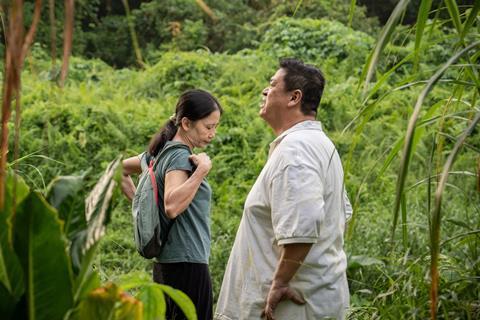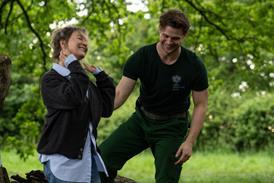Double prize winner at Locarno is an aquatic, magical realist tale from Singapore

Dir/scr: Nelson Yeo. Singapore/Indonesia. 2023. 77mins.
A simple love-triangle develops oddly complex curves in Singaporean writer-director Nelson Yeo’s Dreaming & Dying, a debut which places ravishingly exquisite visuals at the service of an excessively opaque screenplay. Premiering in the Filmmakers of the Present competition at Locarno, the Indonesian co-production not only won the section’s Golden Leopard but also the festival’s overall First Feature Award honouring experimental approaches. This augurs well for subsequent festival exposure but, while this artful, ruminative miniature about three people in their late fifties might strike a chord with some audiences, wider play is less certain.
Functions most effectively as a 77-minute showreel for the cinematography of Lincoln Yeo
Indeed, Dreaming & Dying functions most effectively as a 77-minute showreel for the cinematography of Lincoln Yeo in his his first feature-length outing. Working in the 4:3 format and crafting digital images that have the richness of celluloid, Lincoln Yeo and colorist Eugene Seah conjure a world of vibrant hues — especially azure blue — for a tale in which water features prominently throughout.
It is tempting to describe the film as a Hong Sang-soo reverie on The Shape of Water, with loopy fantastical elements emerging unexpectedly at the 22-minute mark. Up to this point, the script has been a sensitive but rather mundane chronicle of an encounter between an unhappily-married couple (Doreen Toh, Kelvin Ho) and their old school friend Heng (Peter Yu) at a seaside resort. It’s immediately obvious that the wife (never named) still carries quite a torch for the handsome, charismatic Heng. This sharpens her regret that she should have ended up with her boorish, physically ailing husband (also never named).
In the middle of an innocuous chat Heng suddenly reveals that he is a merman — he’s fishy from the waist down, these piscine aspects realised by costuming. Given the pervasive, gently oneiric tone, the implication seems to be that we have crossed from recognisable reality into realms of fable or imagination. A major hint in favour of the latter is that the wife has been reading a romantic novel entitled The Mermaid’s Tale, germane extracts from which are presented via narration and simultaneous on-screen text.
As Dreaming & Dying progresses, certain lines of dialogue recur, certain scenes replay with minor variation. Development of narrative and character are subsumed by teasingly oblique enigmas amid evocations of sensual atmospheres. Cinematographer Yeo’s contributions helpfully boost the latter, likewise the choice of locations such as an old-school amusement-park with cavernous, ornately-decorated grottos.
All settings in the film are populated only by the three main characters; apart from a scattering of folk glimpsed in the distance, no-one else registers at all. The only other speaking character is a fish, a key element in the mid-forest karma-cleansing ritual conducted by the married couple that takes up much of the film’s second half. Such whimsical inventions — and writer-director Yeo’s general penchant for symbolism — rely on audience familiarity with the religious and superstitious beliefs of this region. Outsiders may struggle to piece together what’s going on and why, Dreaming & Dying thus emerging as an intellectual exercise in quasi-narrative magical realism — a confection of enticingly glittery surfaces with insufficient real substance.
Production company: Momo Film Co
International sales: Lights On, info@lightsonfilm.org
Producers: Si En Tan, Sophia Sim
Cinematography: Lincoln Yeo
Production design: Mark Chua, Lou Shenna, Li Shuen Lam
Editing: Armiliah Aripin
Main cast: Doreen Toh, Peter Yu, Kelvin Ho
























![The Brightest SunScreen[Courtesy HKIFF]](https://d1nslcd7m2225b.cloudfront.net/Pictures/100x67/3/5/0/1448350_thebrightestsunscreencourtesyhkiff_312678.jpg)









